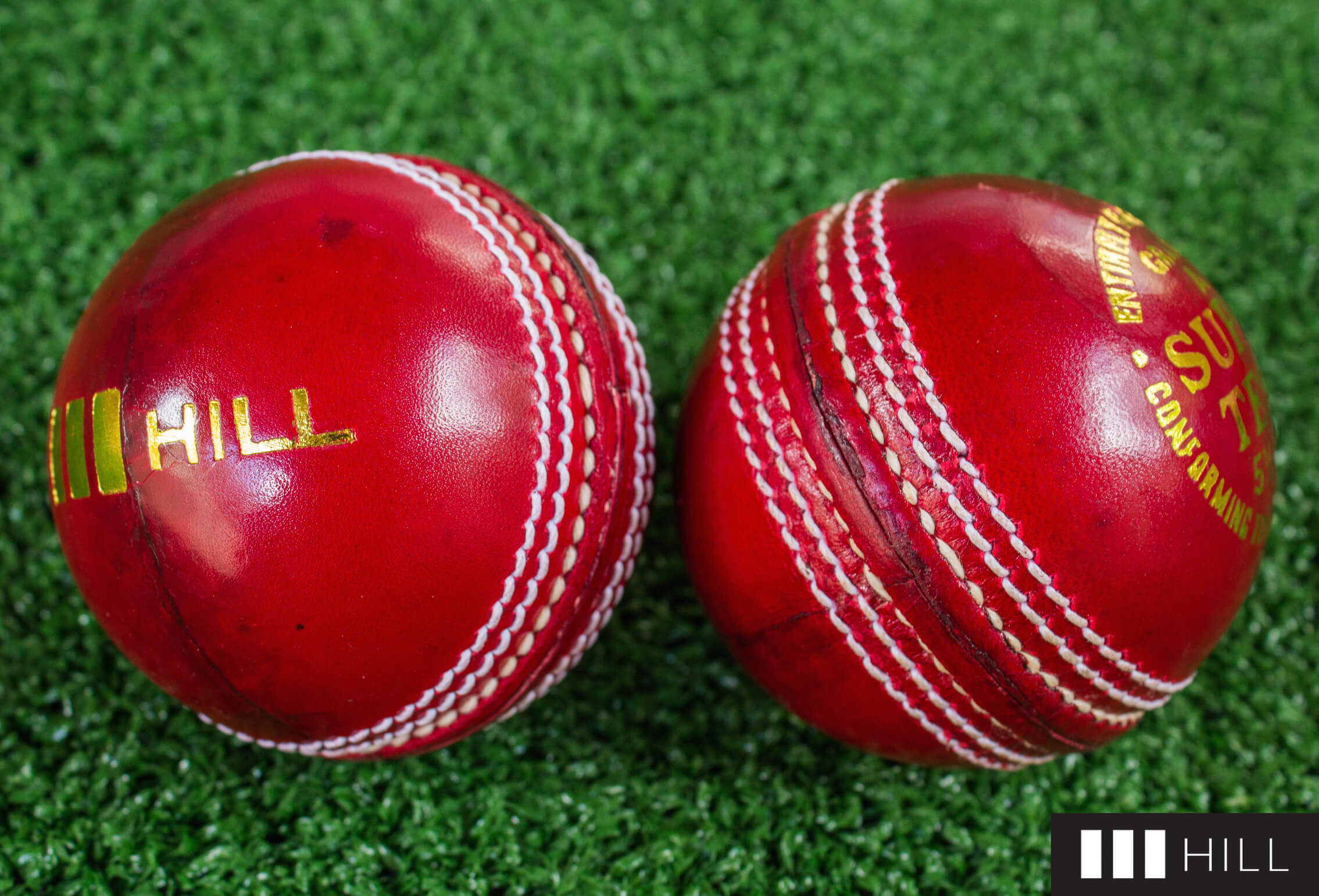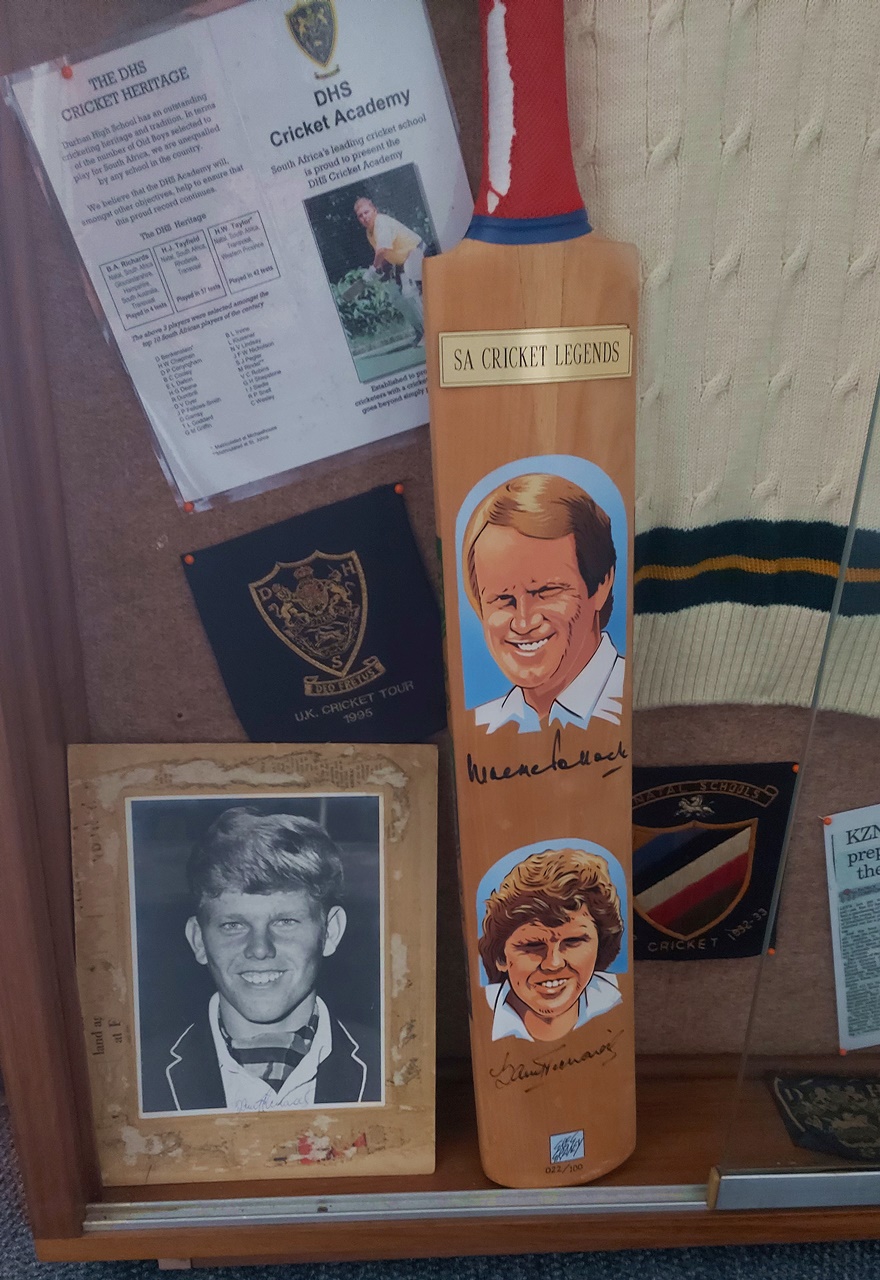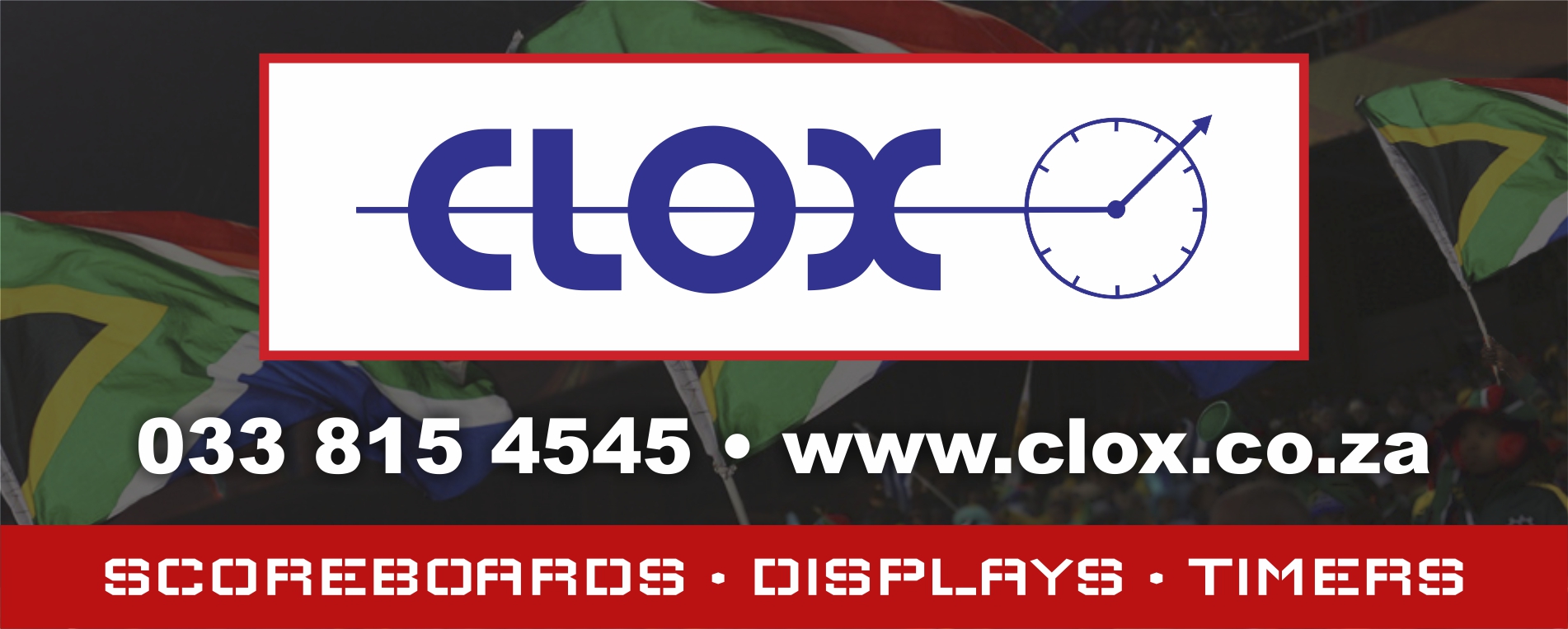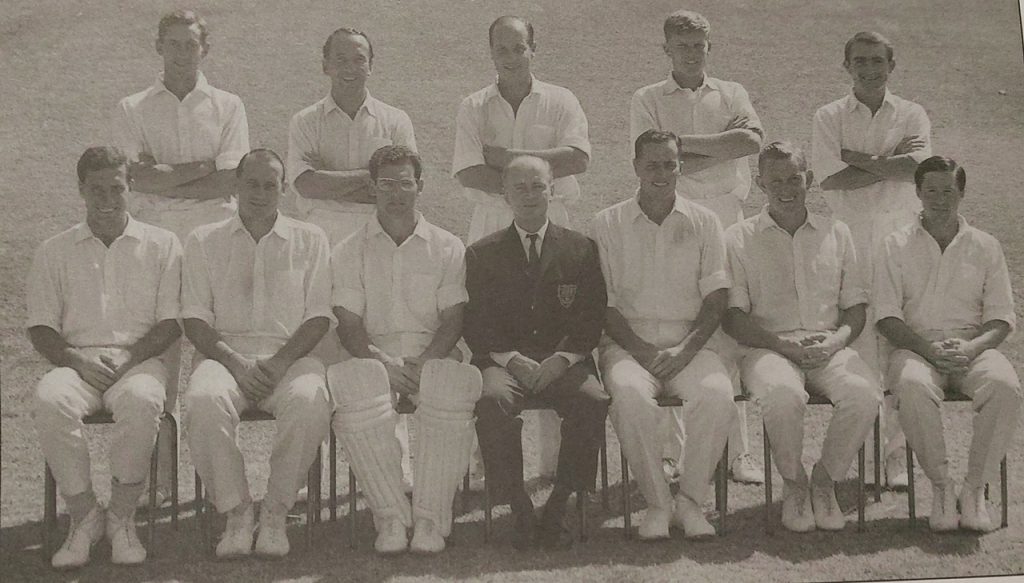Posts Tagged ‘africa’
A golden era of DHS cricket
13 May 2020 – It is a remarkable photo: a collection of supreme cricket talent, all from Durban High School (DHS). Within the photo, taken on the occasion of the centenary of DHS in 1966, are eight test cricketers and three provincial players, writes KZN10.com’s Brad Morgan.
(In photo: back row, left to right: Grayson Heath, Jack Kaplan, Peter Dodds, Barry Richards, Lee Irvine.
Front row, left to right: Richard Dumbrill, Hugh Tayfield, Dennis Gamsy, Leslie Theobald, Trevor Goddard, Geoff Griffin, Colin Wesley)
At the time, the Springboks were one of the leading cricket teams in the world, soon to become recognised as the best, before South Africa was shut out of test cricket from 1971 to 1992 due to the apartheid policies of the country’s government.
Pride of place in terms of achievements from that team must go to Barry Richards, who was 21 at the time of the centenary match.
He played only four test matches in 1970, but went on to make such an impact with Natal, Hampshire and South Australia, with other stints at Gloucestershire and Transvaal too, that Sir Donald Bradman, he of the 99.94 test batting average, named Richards in his Dream XI in 2001. Bradman chose his side from a pool of 69 players and excluded, among others, Brian Lara, Viv Richards and fellow South African, Graeme Pollock. That’s a remarkable statement from the man regarded as the greatest batsman to have played the game.
In late 1970, playing for South Australia against Western Australia, Richards struck an unbeaten 325 runs on the opening day of the four-day Sheffield Shield clash, played on the WACA, which was notorious for its pace.
The Western Australia attack included Graeme McKenzie, who opened for Australia; the great Dennis Lillee who would make his test debut a couple of months later; leg-break bowler, Tony Mann, who played test cricket for Australia; slow left-armer, Tony Lock, who appeared in 49 tests for England; and Aussie international Jon Inverarity. Ian Brayshaw was the sixth bowler in the innings and the only one of them not to appear for his country.
Richards’ stunning innings was for many years the most runs scored by a batsman in first class cricket. It was finally beaten by Brian Lara in 1994, when he made 390 runs against Durham for Warwickshire. Durham had no international bowlers at the time. In fact, they had begun playing first class cricket only two years earlier.
Richards went on to tally 356, out LBW to Mann on a ball that the bowler admitted pitched on leg stump and was a wrong ‘un, set to turn further down the leg.

Hill Premium Quality Cricket Balls stay the distance. www.hillcricketballs.co.za
During his career, Richards totalled 28 358 runs at 54.74, with 80 centuries. In his only test series, the famous 4-0 whitewash of Australia in South Africa, he scored 508 runs at 72.57. His performances were highlighted by a remarkable stand with Graeme Pollock – in the second test in Durban, appropriately – during which he reached 94 by lunch before going on to make 140, while he and Pollock flayed the Australian attack to all corners of Kingsmead, putting on 103 in an hour.
In 1969, he was named one of Wisden’s Cricketers of the Year. In their article, Wisden notes: “Richards recognises his debt to Butler, to Wilf Isaacs, who is always ready and keen to help cricket and cricketers in South Africa, and to Leslie Theobald, his cricket master at Durban High School.”
“When Richards captained the South African Schools side in England in 1963, Mr. Theobald was manager, and their partnership produced outstanding results.”
The article concluded: “Richards’ horizons seem limitless, and it will be fascinating to see how far his talents will take him. Few, anywhere in the world, have his possibilities.”

A photo of Barry Richards in his DHS honours’ blazer alongside a bat signed by Richards and Graeme Pollock.
Lee Irvine, a year older than Richards, also played just four tests in 1970 against Australia. Like Richards, he also excelled. He scored 353 runs at 50.42, including 102 in his final test innings on his 26th birthday.
He played 157 first class matches, for Natal, Essex and Transvaal, tallying 9 919 runs at 40.48, with 21 centuries. It should be mentioned that in those days pitches were tailored to a more equal battle between bat and ball. Nowadays the balance has tilted in favour of batsmen with television’s focus on providing entertainment. Thus, an average of 40, which is very good, would, arguably, have been closer to 50 in today’s conditions.
Ali Bacher, the captain of the 1970 Springboks, once called Irvine the most under-rated batsman in South Africa. “He seemed always to live in the shadows of Barry Richards and Graeme Pollock. What I saw of him during the five-year period we played together, he was certainly in their league,” he said in a newspaper report in The Citizen in 2014.
Interestingly, Irvine and Richards played together for two years at DHS – Richards was a year younger – and Irvine, in his matric year, performed better than Richards managed in any of his three years in the 1st XI, scoring 1 310 runs at an average of 68.95.

Check out the Cell C personal and business contracts at https://www.cellc.co.za/cellc/contracts
“There was no question he was a world class batsman. He was light on his feet, had terrific footwork and he was a beautiful timer of the ball, very similar to AB de Villiers,” Bacher said.
Leading cricket commentator Mark Nicholas compared Irvine, a wicket-keeper, to Australian Adam Gilchrist, high praise indeed.
After his playing days were over, Irvine became a familiar voice to radio listeners and television viewers of cricket.
As if two world class talents were not enough in the centenary match of 1966, there was a third: off-spin bowler Hugh Tayfield. For many years, he was South Africa’s leading test wicket-taker and in 1956 he was named one of Wisden’s Cricketers of the Year.

DHS old boys: Jon “Pom Pom” Fellows-Smith, Geoff Griffin, Colin Wesley, Trevor Goddard and Hugh Tayfield. all members of the South African national team that toured England in 1960.
In an article about his selection, the publication wrote: “In the seventeen Tests played by South Africa from 1952 to the end of the 1955 tour of England, J. E. Cheetham’s spin bowlers accounted for 109 batsmen. Of these, no fewer than 87 fell to the guileful, tenacious Tayfield, an average of four out of every five.”
It also recognised the development of Tayfield at DHS: “As a boy, Hugh bowled out of the back of his hand and though his batting and fielding were sufficient to keep him in the Durban High School XI his opportunities with the ball were limited. The turning-point in Tayfield’s career occurred when the school captain, also a leg-break bowler, suggested that Tayfield should try his hand at off-breaks.
“At his first attempt Hugh took two or three good wickets and promptly resolved to concentrate on his new-found art. Tayfield cannot recall being coached or modelling his technique on that of any other bowler, but he progressed so rapidly that soon after his seventeenth birthday he made his first-class debut for Natal. The following season, 1946-47, he helped Natal to win the revived Currie Cup competition and attracted special attention by taking six for 27 and six for 46 in friendly matches against Rhodesia and Transvaal respectively.”

When the match is tight and every run counts, you can count of Clox Scoreboards of KZN. http://clox.co.za/
The 13 for 165 he took against Australia in Melbourne in 1956 remains the third best test return ever by a South African bowler and he, alone, is the only South African to take 13 wickets in a test twice. His 9 for 113 in England’s second innings in Johannesburg in 1957 is the best return in an innings by a South African, and it also saw the Springboks to a narrow 17-run victory.
Tayfield’s test career spanned 11 years – from 1949 to 1960 – and 37 test matches (South Africa played only England, Australia and New Zealand in those days), during which he took 170 wickets. His obituary in Wisden in 1994 noted that he took more wickets per test than Jim Laker (he of the famous 19 for 90 against Australia in 1956) and more, too, than the great West Indian, Lance Gibbs.
Tayfield also holds the test record of sending down 137 balls without conceding a run against England in Durban in 1957.
He played in 187 first class matches, capturing 864 wickets at just 21.86 per wicket. His test economy rate was just 1.94 runs per over and his first class economy rate of 2.06 was very slightly higher.
He also scored 862 runs in tests and 3 668 in first class cricket, with a best of 75 in tests and 77 in first class games.
To this day, Hugh Tayfield remains, comfortably, the leading test wicket-taker all-time among South African spinners.

Trevor Goddard, a left-handed all-rounder, was also part of the legendary Springbok side of 1970. But he enjoyed a much longer test career, having played for South Africa for the first time in 1955.
He played 41 test matches, scoring 2 516 runs at an average of 34.46. A century, though, eluded him until his 62nd innings, when he scored 112 in the second innings of the fourth test against England in Johannesburg in 1965, having made 60 before being run out in the first.
Goddard also captured 123 wickets at 26.22. He gave little away with the ball and his economy rate of just 1.64 runs per over is the best in test history for bowlers taking 30 or more wickets.
He is also part of a small, select group of players who have opened both the batting and bowling in the same test for their country. Interestingly, one of the other South Africans to have achieved the feat was Herbie Taylor, who did it twice in 1914 against England. Taylor also attended DHS and, like Barry Richards and Hugh Tayfield, was named one of Wisden’s Cricketers of the Year, with his recognition coming in 1925.
According to Sir Donald Bradman, Goddard was “a very fine cricketer”.
Goddard played 179 first class matches, scoring 11 289 at 40.60, including 26 centuries, and took 534 wickets at 21.65.
Geoff Griffin is an interesting name among these great DHS old boys and cricketers. He played only two test matches, but he achieved a first by a South African, which can never be taken away from him
In the second test of South Africa’s tour of England in 1960, Griffin claimed a hat-trick, removing MJK Smith, Peter Walker and Fred Trueman. Not only does his hat-trick remain the only instance of a South African taking a test hat-trick, it is also the only instance of it occurring at Lords, the home of cricket.
Unfortunately, he was also no-balled in that test on a number of occasions for throwing. His throwing issues stemmed from an accident when he was in school which left him unable to fully straighten his arm. The no ball calls led to Griffin, remarkably, claiming a hat-trick in his second and last test.
Sadly the throwing problem was never resolved and Geoff Griffin’s first class career came to an end at the age of only 23. He captured 108 wickets at 21.61 and scored 895 runs at 17.90.
It is a credit to Griffin’s character that when a lawyer offered to represent him in court on the subject of his action, Griffin, as reported by Cricinfo in his obituary, declined as he did not wish “to sully the great game further”.
A remarkably talented all-round sportsman, he won Natal schools’ titles in long jump, high jump, triple jump and the pole vault. He also played hockey for Rhodesia.

Pivotal Talent’s Online SubjectChoice (Grade 9s) and CareerGuide (Grade 10s, 11s and 12s) solutions replaces uncertainty with accuracy in directing your children to make full use of their potential. Check out www.careerguidesolution.co.za
Wicketkeeper Dennis Gamsy was another member of the 1970 South African team, who played in the first two tests before making way for the experienced Denis Lindsay, the hero of the 1966/67 series against Australia.
Easily recognised by his distinctive glasses, Gamsy also played 93 first class matches for Natal, scoring 3 106 runs at 23.70, with a batting best of 137. He took 278 catches and effected 33 stumpings.
Richard Dumbrill also donned the green cap of the Springboks, playing in five tests in the mid-sixties. In fact, his last test, against Australia, started on 31 December 1966 at Newlands, therefore in the centenary of DHS.
His first test, a draw against England at Lords in July 1965, was his most successful. He took 3 for 31 in 24 overs in England’s first innings and followed up with 4 for 30 in 18 overs in the second to finish with match figures of 7 for 61.
Dumbrill’s first class career lasted 51 matches. In that time he tallied 1 761 runs at 23.48 and claimed 132 wickets at 22.03, with a best return of 5 for 34.

A sticky wicket makes for messy backyard cricket. Take action before it’s too late. www.midlandssepticservices.co.za
Colin “Tich” Wesley was selected for three tests during South Africa’s 1960 tour of England. Like Dumbrill, he played just 51 first class games. He scored 1 892 runs at 27.02, including three centuries, with a high score of 131.
A part-time bowler, Wesley picked up 15 wickets at a healthy average of 23.60, conceding 2.31 runs per over.
The remaining three players in the photo all played provincial cricket. Grayson Heath turned out in 46 first class matches, scoring 2 029 runs at 31.21, with a top score of 159 not out. He also claimed 36 wickets at 29.08.
Importantly, he also oversaw the merger of DHS Old Boys and the Pirates Kismet Cricket Club at a time when the DHSOB club, previously home to a long list of top cricket stars, went through a downswing. Today, that club is the DHS Rhythm Cricket Club.
Peter Dodds turned out for both Natal and Transvaal. A slow left-armer, he took 120 wickets in 39 first class games at 29.07, including a best of 7 for 51.
Jack Kaplan, a right-hand batsman and wicketkeeper, played in eight first class matches between the 1948/49 and 1951/52 seasons. He batted only 11 times, recording a high score of 62. He also bagged 15 catches and a remarkably high eight stumpings.

When it comes to a great getaway look no further than the five star Fordoun Hotel Spa and Restaurant in the leafy peace and quiet of Nottingham Road. Use Fordoun as your base to explore the delights of the KZN midlands. Go to https://www.fordoun.com/
About the centenary match, which was played at the DHS Old Boys’ Club: It was a two-day, two-innings, contest between the DHSOB XI and a Natal XI.
The Rest of Natal XI featured four Springboks: captain Jackie McGlew, Peter Carlstein, Mike Proctor and Pat Trimborn. It also featured another two DHS old boys, namely Charles Sullivan and Peter Marais.
In the game, Richard Dumbrill struck 114 and shared a partnership of 127 with Lee Irvine in the DHSOB XI’s first innings, but they found themselves trailing by 64 runs. The Old Boys were subsequently set a target of 188 runs to win in two-and-a-half hours and managed it in just an hour and 47 minutes for the loss of seven wickets to claim a three-wicket victory.
To this day, no school has produced as many South African test cricketers as Durban High School.
DHS come up just short as Northwood take tight victory
https://kzn10.com/dhs-come-up-just-short-as-northwood-take-tight-victory/
Captain Matkovich guides Westville to win at DHS
https://kzn10.com/captain-matkovich-guides-westville-to-win-at-dhs/


